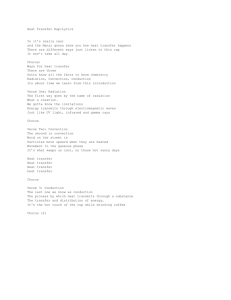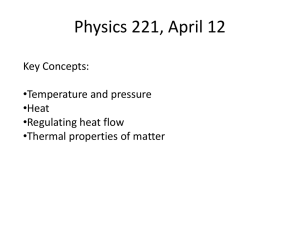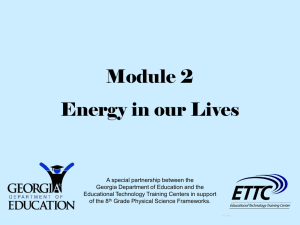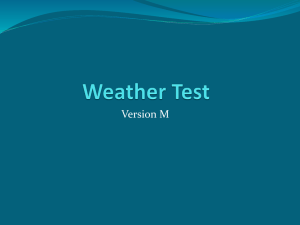Study Island Assignment_Thermal Energy Transfer
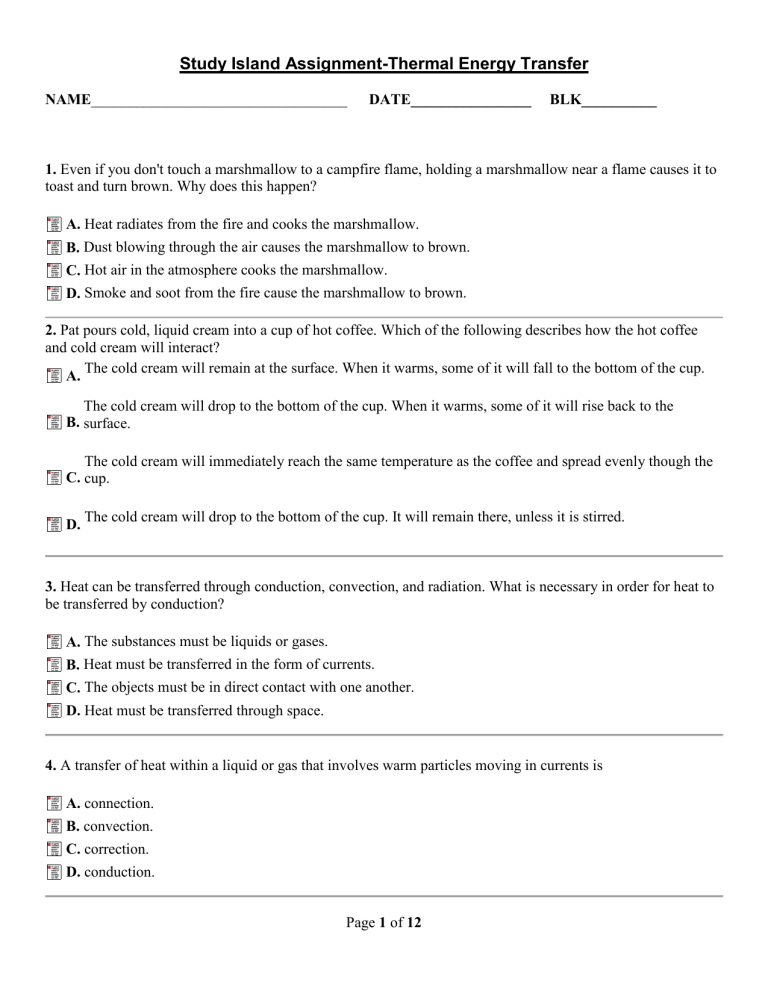
Study Island Assignment-Thermal Energy Transfer
NAME __________________________________ DATE________________ BLK__________
1.
Even if you don't touch a marshmallow to a campfire flame, holding a marshmallow near a flame causes it to toast and turn brown. Why does this happen?
A.
Heat radiates from the fire and cooks the marshmallow.
B.
Dust blowing through the air causes the marshmallow to brown.
C.
Hot air in the atmosphere cooks the marshmallow.
D.
Smoke and soot from the fire cause the marshmallow to brown.
2.
Pat pours cold, liquid cream into a cup of hot coffee. Which of the following describes how the hot coffee and cold cream will interact?
A.
The cold cream will remain at the surface. When it warms, some of it will fall to the bottom of the cup.
The cold cream will drop to the bottom of the cup. When it warms, some of it will rise back to the
B.
surface.
The cold cream will immediately reach the same temperature as the coffee and spread evenly though the
C.
cup.
D.
The cold cream will drop to the bottom of the cup. It will remain there, unless it is stirred.
3.
Heat can be transferred through conduction, convection, and radiation. What is necessary in order for heat to be transferred by conduction?
A.
The substances must be liquids or gases.
B.
Heat must be transferred in the form of currents.
C.
The objects must be in direct contact with one another.
D.
Heat must be transferred through space.
4.
A transfer of heat within a liquid or gas that involves warm particles moving in currents is
A.
connection.
B.
convection.
C.
correction.
D.
conduction.
Page 1 of 12
5.
A slice of cheese is 3.0°C and is sitting on a dish that is 3.0°C.
If the dish and cheese are in a refrigerator that is set to 3.0°C, which of the following statements is true?
A.
Heat will flow from the air in the refrigerator to the cheese and the dish.
The temperature of the air in the refrigerator will decrease and the temperature of the cheese will
B.
increase.
C.
Heat will not flow because there is no temperature difference between the substances.
D.
The temperature of the cheese will increase and the temperature of the dish will decrease.
6.
Sunlight heats the ground, and the ground warms the nearby air. The warm air expands and rises, while cool air rushes in to take its place.
The example above describes the process that generates many surface winds. Surface winds are an example of _______ in the Earth's atmosphere.
A.
condensation
B.
convection
C.
conduction
D.
radiation
Page 2 of 12
7.
Which of the following is an example of conduction?
A.
A metal spoon becomes warm when placed in a cup of hot tea.
B.
A dog's bowl of water warms up out in the Sun.
C.
Leftovers become warm when reheated in the microwave.
D.
Campers warm up while sitting by a campfire.
8.
Radiation, conduction, and convection are methods of energy transfer. Of these methods, radiation is the only one in which energy can be transferred through _______.
A.
solids.
B.
liquids.
C.
space.
D.
matter.
9.
Jackson is designing a new heater, and he wants to experiment with different thermally conductive materials.
Which of these materials would be useful in conducting heat?
A.
aluminum
B.
soil
C.
cork
D.
wood
10.
Before breakfast, Lacie dropped an ice cube into her coffee. After a few seconds, she noticed that the ice cube had melted in the coffee. Which of the following statements correctly explains what Lacie witnessed?
A.
The cold from the ice cube was transferred into the coffee, which melted the ice.
B.
The basic ice cube reacted with the acidic coffee, which caused the ice cube to melt.
C.
The cold from the ice cube went into the air, which melted the ice.
D.
Heat from the coffee transferred into the ice cube, which melted the ice.
11.
The light from the Sun heats a metal surface. This is an example of
A.
conduction.
B.
convection.
C.
radiation.
D.
reflection.
Page 3 of 12
12.
The heat from the Sun must pass through the vacuum of space before it reaches the Earth. Which process is illustrated in this example?
A.
conduction
B.
radiation
C.
convection
D.
induction
13.
What property of a stainless steel cooking pot makes it useful for cooking?
A.
thermal insulation
B.
thermal conduction
C.
metallic shine
D.
hardness
14.
A candle is lit. The heat of the flame will melt the candle because
A.
the candle must stay hot to heat the flame.
B.
the heat of the hot flame is transferred to the colder candle.
C.
the wax of the candle is repelled by the flame.
D.
the flame takes all the heat energy and the candle has no energy.
15.
Allen wants to make a box to keep foods hot. What material would be best for him to use in his box?
A.
rubber
B.
aluminum foil
C.
stainless steel
D.
glass
16.
Energy that transfers between substances because of a temperature difference between the substances is known as _______.
A.
chemical energy
B.
heat energy
C.
potential energy
D.
electromagnetic radiation
Page 4 of 12
17.
Which of the following processes transfers heat?
A.
convection
B.
conduction
C.
radiation
D.
all of these
18.
Which of the following is an example of convection?
A.
the rays of the Sun warming the earth
B.
a hot object transferring heat to a cooler one
C.
hot air rising and cooler air falling
D.
a hot oven warming the air around it
19.
Shane is building a bench. He lives in a very hot climate, so he wants to build the bench out of material that does not conduct heat.
In order to keep the bench from conducting heat, Shane could build it out of _______.
A.
wood
B.
aluminum
C.
iron
D.
copper
20.
June is building a circuit. She wants to add something that will conduct electricity.
June wants to add ___________ to her circuit, so she chooses _____________.
A.
an insulator, a copper wire
B.
a conductor, a copper wire
C.
an insulator, plastic
D.
a conductor, plastic
21.
Cindy makes herself a cup of hot chocolate on a very cold day. If Cindy's hands are very cold and the cup is very hot, heat energy transfers from the cup to her hands because
A.
of the size difference between them.
B.
one is a solid and the other is mostly a liquid.
C.
of the temperature difference between them.
D.
cold energy spreads from cool objects to warm objects.
Page 5 of 12
22.
A hot saucepan is placed on a cold bench. Heat will flow from the saucepan to the bench until
A.
the bench is warmer than the saucepan.
B.
the saucepan and bench are at the same temperature.
C.
the saucepan has lost all of its heat.
D.
the bench is as hot as the saucepan was.
23.
Mildred takes a pound of frozen hamburger meat out of the freezer and puts it into the refrigerator.
Which of the following best describes the direction of heat flow?
A.
from the hamburger to the air in the refrigerator
B.
from the air in the refrigerator to the hamburger
C.
from the air in the freezer to the air in the refrigerator
D.
from the hamburger to the air outside the refrigerator
24.
When bridges are built, special joints must be used because the material of the bridge shrinks, and without these joints, the material would break. Which of the following properties is described here?
A.
thermal expansion
B.
thermal decay
C.
thermal contraction
D.
thermal stasis
Page 6 of 12
25.
Which of the following is an example of heat transfer through conduction?
A.
the Sun drying clothes hanging outside
B.
a microwave warming a cup of water
C.
a pan on the stove getting hot
D.
hot air rising inside a house
26.
Jimmy held the end of a metal bar over a fire while holding on to the opposite end. After a few minutes, the end he was holding began to get very hot. Which process is illustrated in this example?
A.
convection
B.
induction
C.
radiation
D.
conduction
27.
A pot is on a hot stove.
What carries most of the heat from the bottom of the pot to the top of the pot?
A.
collisions of energetic atoms and molecules
B.
flammable particles inside of the pot
C.
particles of light shooting through the pot
D.
a heat force generated by the flames
Page 7 of 12
28.
Which of the materials below would be best to use to complete an electrical circuit?
A.
wood
B.
pencil lead
C.
aluminum foil
D.
air
29.
Sandy has just made a pitcher of hot tea. She pours the tea into a cup and picks it up. The cup acts as an insulator, so Sandy can pick up the cup even though the liquid inside is hot.
Of what material could the cup be made?
A.
wood
B.
plastic
C.
glass
D.
all of these
30.
Samantha's class is learning about conductors and insulators of electricity. She studies an appliance cord that has been cut to show the two main parts. The cord is made up of a metal wire and a plastic covering.
The metal wire is ____________, and it...
A.
an insulator; does not allow electricity to flow.
B.
a conductor; does not allow electricity to flow.
C.
an insulator; allows electricity to flow.
D.
a conductor; allows electricity to flow.
31.
Through which of the following ways does the Sun primarily transfer its heat energy to the Earth?
A.
convection
B.
reflection
C.
conduction
D.
radiation
32.
Which of the following is an example of heat transfer by radiation?
A.
a fire warming a group of campers
B.
the Sun warming the Earth
C.
an electric space heater warming a room
D.
all of these
Page 8 of 12
33.
Which of the following statements about radiation is true?
A.
Radiation is the only form of heat transfer that is experienced on Earth.
B.
Radiation is the only form of heat transfer that can travel through the vacuum of space.
C.
Radiation is the only form of heat transfer that is unable to travel through the vacuum of space.
D.
Radiation is the only form of heat transfer that is not experienced on Earth.
34.
Kelly made an electrical circuit using copper wire, a lightbulb, a battery, and a lemon. When she connected the circuit by sticking two wires into the lemon, the lightbulb lit up. What does this demonstrate about the lemon?
A.
Lemon skin is a good insulator of electricity.
B.
Electricity can be conducted by any material.
C.
Lemon juice is a good conductor of electricity.
D.
Copper wire is a good insulator of electricity.
35.
Which of the following is a true statement about heat transfer?
A.
Heat never transfers from solids to liquids.
B.
Heat always flows from cooler objects to warmer objects.
C.
Heat always flows from warmer objects to cooler objects.
D.
Heat never travels in a similar pattern.
36.
Once heat from the Sun penetrates the Earth's atmosphere, the heat is circulated as warm air rises and cold air sinks. What is this process called?
A.
convection
B.
reflection
C.
conduction
D.
radiation
37.
In which of the following methods of heat transfer is it necessary for the objects to be directly touching one another?
A.
radiation
B.
conduction
C.
convection
D.
all of these
Page 9 of 12
38.
Which types of heat transfer involve heat flow from hot objects to colder objects?
A.
convection, but not conduction or radiation
B.
convection, conduction, and radiation
C.
convection and conduction, but not radiation
D.
convection and radiation, but not conduction
39.
Which of the following is the correct definition of conduction ?
A.
the transmission of heat across empty space
B.
the transmission of heat across matter
C.
the transfer of heat by currents within a liquid or gas
D.
the electromagnetic radiation from the surface of an object which is due to the object's temperature
40.
A thermometer contains liquid mercury, and the volume of that mercury grows as the temperature grows, allowing us to make accurate measures of temperature. Which of the following properties of mercury is described here?
A.
thermal contraction
B.
thermal growth
C.
thermal stasis
D.
thermal expansion
Page 10 of 12
41.
Bob has a cup of hot chili. It is too hot to eat.
After ten minutes, the chili is cool enough for him to eat.
What has happened to the chili's thermal energy?
A.
It has increased the chili's potential energy.
B.
It has increased the air's thermal energy.
C.
It has increased the air's potential energy.
D.
It has increased the chili's kinetic energy.
42.
Heat will flow from a hot object to a cold object until the objects reach
A.
equilibrium.
B.
boiling point.
C.
stability.
D.
collapse.
43.
Jared is building an electrical circuit that includes a battery and a lightbulb. He knows that the circuit needs to be a closed loop, so he connects the battery to the lightbulb with a plastic string, then connects the lightbulb back to the battery with another plastic string. He checks to make sure that everything is connected, but the lightbulb does not light.
What is most likely the problem with the circuit?
A.
The light bulb is broken.
B.
Plastic is not a conductor of electricity.
C.
The battery is dead.
D.
Plastic conducts too much electricity.
Page 11 of 12
44.
Heat energy is transferred by conduction whenever molecules
A.
change forms.
B.
spread apart.
C.
collide.
D.
fuse together.
45.
Which of the following is the correct definition of radiation ?
A.
the electromagnetic radiation from the surface of an object which is due to the object's temperature
B.
the transfer of heat by electrical currents
C.
the transfer of heat by currents within a liquid or gas
D.
the transmission of heat across matter
46.
Ice is placed in hot water. What happens to the temperature of the ice and the water?
A.
The ice gets cooler, and the water gets warmer.
B.
The ice gets warmer, and the water stays the same.
C.
The ice gets warmer, and the water gets cooler.
D.
The ice and the water both get cooler.
47.
A light bulb lights up because energy, in the form of an electric current, is transferred from a power supply to the filament inside the light bulb. This kind of energy transfer is known as _______.
A.
convection
B.
conduction
C.
radiation
D.
mechanical energy
Page 12 of 12




